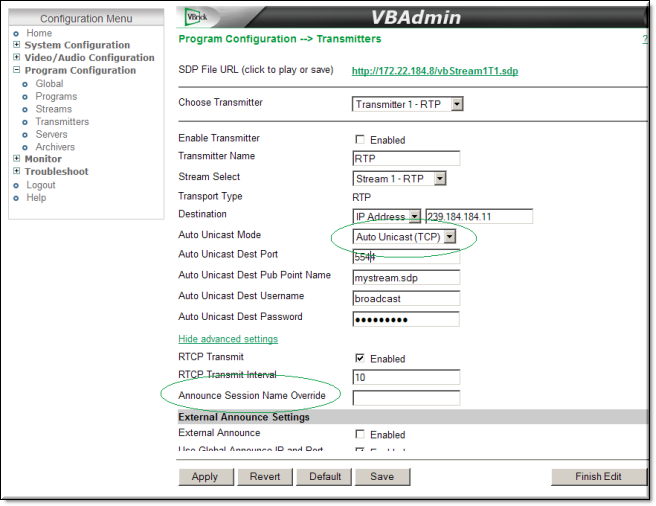In-2 < RTP Auto Unicast
From a source perspective, these two mechanisms are very similar. The only major difference is whether the stream is sent to the RTP Server or the Multi-protocol server. This is determined by DME port that the stream is sent to. In general, In-2 is preferred to In-3. The only situation where In-3 should be used is if the UDP protocol is required. since IN-2 does not support UDP. Note that depending on the mechanism used, and the output protocols required, manual configuration of In-6 or Out-10 is needed so the stream can pass between the two servers.
This use case is commonly used to publish streams to the DME from VB7000 encoders running v3.0 or earlier software. These early versions of the VBrick appliance did not support RTMP, hence the preferred mechanism of RTMP Push (IN-1) is not available. In this scenario the input is sourced from an Auto Unicast transmitter on a VBrick 7000/9000 Series (H.264) encoder. Auto Unicast is a transmitter mode that allows the VBrick encoder to “automatically” establish and maintain a connection with a streaming server. The stream is pushed to a configured publishing point location on the DME to which external clients can connect to retrieve the stream. For example, you can place a VBrick encoder inside a private network and configure it to Auto Unicast to a DME. External clients will then connect to the DME server via the Internet. Auto Unicast uses RTSP to control the session. It establishes a connection with the streaming server, negotiates ports, and begins streaming to the server. Once established, the encoder will push this stream to the DME until the session is terminated (typically by disabling the transmitter).
In the case of both In-2 and In-3, the Auto Unicast transmitter can be configured to send a UDP stream or a TCP stream. The key difference is that a TCP stream provides guaranteed delivery and therefore adds additional overhead; UDP does not and lost UDP packets are not retransmitted. If overhead is not a factor, TCP is recommended. See the "Auto Unicast Mode" topic in the H.264 Encoder Appliance Admin Guide for more information. In addition, please keep the following points in mind when configuring this input method:
●If using UDP (IN-3), the DME chooses the audio and video ports. The default DME Auto Unicast Destination Port = 554.
●If using In-3 or In-2 and Flash Server Authentication is enabled on the DME Security page, you will need to configure an Auto Unicast Destination Username and Password.
●This input method has the desirable characteristic that no input configuration is required on the DME so the stream name is generated by the stream configuration parameters on the source side. This name must be unique in the DME. derived from two encoder parameters which must be configured to be consistent. One of these is the sdp file name. The second name source is the incoming program name. In some cases, multiple streams with different bit rates are to be sent to the DME. In these cases, the unique program names are preserved using the Announce Session Name Override parameter to override the common program name.
Figure 1. Encoder Auto Unicast Listener
 To configure an RTSP announce (RTP) input:
To configure an RTSP announce (RTP) input:Objective: Send a unicast set of streams via Auto Unicast to the DME as input. RTP streams can be generated either by an encoder or another DME, and the corresponding SDP file describes the RTP stream(s).

Configure your encoder as follows:
1. Set the desired Audio/Video configuration for frame rate, resolution, video and audio rate, sampling frequency etc.
2. Select a stream to send, set the stream type to RTP, and select the streams you want to send to the DME (including audio, video, or both).
3. Select a transmitter to use for the selected stream and setup the information to send the stream out to the DME. Select either auto-unicast UDP or auto-unicast TCP. If transmitting to the Multi Protocol server, only TCP may be used. The destination port, must be the Multi-Protocol or the RTP Server port as configured on the DME. The destination of the stream is the IP address or hostname of the target DME. Do not use the hostname of the DME unless it is registered via DNS. Also enter the user name and password of the DME to receive the stream if using In-3 or if required and using In-3. By default, the username and password are broadcast/broadcast but may have been changed by the DME administrator.
4. Configure the DME stream name by setting the Program name, sdp file name, and Announce Session Override as required per the discussion above.
5. Enable the stream to be sent to the DME.

See Also:

